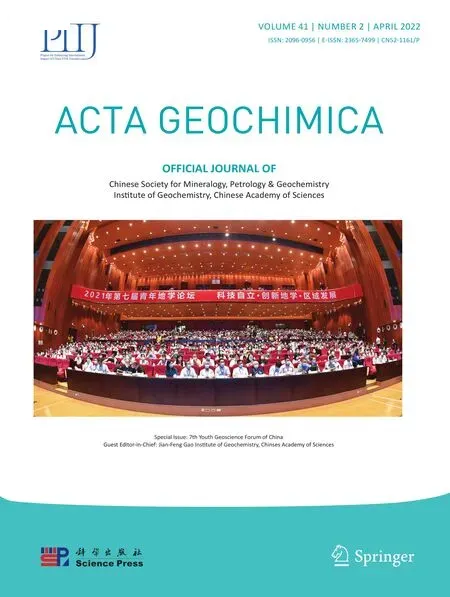Geochronology and geochemistry of the W-Mo-ore-related granitic rocks from eastern Ningzhen, lower Yangtze river belt,eastern China
Fangyue Wang ? Yongjie Guo,3 ? Haiyang Yan ? Haiou Gu ?He Sun ? Can Ge
Abstract Here we present zircon U–Pb–Hf and wholerock major and trace element studies of eastern Ningzhen W-Mo-ore-related magmatic rocks, Yushan and Longwangshan granitic rocks, to constrain their form timing,magma sources, and tectonic settings.The results showed that the two plutons were formed in the Early Cretaceous with 206Pb/238U ages of 107.8 ± 1.2 and 105.2 ± 1.5 Ma(206Pb/238U),respectively.The trapped/residual zircons are mainly distributed in 2.0–2.5 Ga.The two intrusions are characterized by high silicon (68.60–73.99%), high aluminum (13.56–15.02%), high Mg# (47–55), high Sr, Sr/Y,LaN/YN, and low Yb, falling into high Mg# adakitic rock region.The zircon εHf (t) values of the two intrusions range from -24.8 to -13.2, indicating an ancient continental crust in their magma sources.The average Ti-inzircon temperature is 689 °C, slightly higher than those of other high-Mg adakitic rocks in the lower Yangtze River belt, but lower than those of high-Mg adakitic rocks in the Southern Tanlu Fault(STLF).Zircon Ce4+/Ce3+show low oxygen fugacity(LWS-1:3–400,average 92;sample ZYS-4:9–382,average 93).These geochemical features indicate a thickened lower continental crust in the Eastern Ningzhen region in a subduction setting.Comparing the geochemical characteristics of the eastern Ningzhen to the western Ningzhen and other areas in the Lower Yangtze River Metallogenic Belt (LYRMB) and the high-Mg ore-barren adakitic rocks of the STLF, we propose that the magmatic rocks from eastern Ningzhen may be mainly from a thickened lower continental crust that hybridized with a very small part of mantle sources,while the west Ningzhen magmatic rocks may have experienced a higher degree of mantle contaminations in their source.The metallogenic differences between the eastern(W–Mo)and western(Cu–Fe–Pb–Zn) parts of Ningzhen also indicate different proportions of crustal materials in their magma source.
Keywords Ancient lower continental crust ?Paleo-pacific plate ?High Mg# adaktic rocks ?Early cretaceous ?Ningzhen ?Crustal thickening
1 Introduction
Eastern China is a typical continental margin during the Early Cretaceous(Chu et al.2019;Li et al.2019;Li and Li 2007; Zhou et al.2006).In the Mesozoic, eastern China underwent significant crustal reworking, characterized by crustal shortening, extension,and voluminous magmatism.Diverse geodynamic models have been proposed to explain the Late Mesozoic tectonomagmatic events in eastern China.(1) Change of subduction angle (Zhou et al.2006;Zhou and Li 2000); (2) Flat subduction and slab rollback(Li et al.2010a;Li and Li 2007;Wang et al.2014a,b;Wu et al.2012); and (3) Changes in the polarity of subduction(Sun et al.2007;Wang et al.2011).These models provide insights into the geodynamic mechanism of this region.Although they are different in detail, they all agree on paleo-Pacific plate subduction in eastern China during the Mesozoic.
Ningzhen district has as many as 54 ore deposits(mainly W-Mo-Cu-Fe-Pb–Zn) in this region (Chen et al.1993).Most of these deposits are time-specially related to Early Cretaceous calc-alkaline intrusive rocks with adakitic affinities (Lu et al.2019a, b; Xu et al.2002; Xue 2019).The ore-related intrusions were well developed, and especially in the center Ningzhen region,and less in eastern and western Ningzhen (Xia, 2000).The magmatic rocks were mainly composed of dioritic porphyry, quartz diorite,granite, etc.Previous studies show these rocks have high Mg#, high Sr/Y, and low Yb, low radiogenic Pb isotope geochemical signatures(Xu et al.2002).From west to east,the magma becomes more evolved, e.g., eastern Ningzhen shows higher SiO2than western Ningzhen plutonic rocks(Xia 2000).The magmatic rocks in eastern Ningzhen are mainly felsic composition with higher SiO2contents(>70 wt.%) (Lu et al.2019a, b) and related to W-Mo ore mineralization.
Previous studies mainly concentrated on magmatic rocks in the western Ningzhen region (Lu et al.2019a, b;Xu et al.2002; Xue 2019).And many high precise zircon U–Pb dating results were also reported there (Lu et al.2019a, b with references therein).The western region is mainly composed of intermediated-acid rocks (Xu et al.2002; Xue 2019) and related to Mo-Cu-Fe deposits, like Anjishan skarn Cu deposit, Tongshan skarn Cu-Mo deposit, and Weigang skarn Fe deposit (Sun et al.2013a,b).According to high Sr/Y,high Mg#,low Yb,and low radiogenic Pb isotopes, Xu et al.(2002) proposed Cu-Fe-related magmatic rocks were from the delaminated old continental crust.However, zircon Ce4+/Ce3+, Eu/Eu*,and oxygen isotopes show the high oxygen fugacity and high water contents in their magma sources contradict the previous model (Wang et al.2014a, b).According to the time and spatial distributions of magmatic rocks in LYRB,flat subduction and rollback model was proposed (Li et al.2010a; Wang et al.2014a, b; Yang et al.2014).
Compared to extensive studies in western Ningzhen,few studies were carried out in eastern Ningzhen.The reason for the geochemical and ore-type differences between eastern Ningzhen and western Ningzhen is not well constrained yet.In this paper, based on detailed field observation, LA-ICP-MS zircon U–Pb-Hf and REE and wholerock geochemistry of the W–Mo related plutons (Yushan and Longwangshang in Jianbi town) in the eastern Ningzhen region were studied.We found many geochemical differences between western Ningzhen and Eastern Ningzhen.These differences may be caused by different proportions of crustal materials in their magma source.
1.1 Geological background
Lower Yangtze River Belt (LYRB) is located in the north margin of Yangtze Block and bordered by North China Craton and Dabie-Sulu ultra-high-pressure belt in the north(Li et al.1993).This belt was bounded by Xiangfan-Guangji fault and Tanlu fault to Dabie orogenic belt in the north, and Changzhou-Yangxin fault in the southeast (Pan and Dong 1999).The fault system of LYRB may have been initiated in the Neoproterozoic and subsequently reactivation during the Triassic and Jurassic-Cretaceous, developing an extensive network of faults and S-style folds.The Late Mesozoic NE-SW trending faults and folds are genetically linked to subduction of the paleo-Pacific plate.It is a ‘‘V’’ shape, situated along the Yangtze River valley(Chang et al.1991).
The Lower Yangtze River Metallogenic Belt(LYRMB)is one of the most important metallogenic belts in China,especially in eastern China.It contains more than 200 middle-giant Cu-Fe-Au-Pb–Zn-S deposits.Seven ore mining districts were defined as Edong, Jiurui, Anqing-Guichi,Luzong,Tongling,Ningwu,Ningzhen from west to east, respectively (Pan and Dong 1999; Pirajno and Zhou 2015).The former 6 clusters were formed at about 145–130 Ma, but the Ningzhen ore cluster is ca.20 m.y.younger (Sun et al.2013a, b; Wang et al.2014a, b; Zhou et al.2015) than others but the ore deposit type is almost the same.The tectonic setting of the Ningzhen district is hotly debated.
Ningzhen region in Jiangsu Province represents the eastern end member magmatism in the LYRB.The tectonic setting is similar to the other region of the LYRB.The tectonics framework in the Ningzhen region shows the east-to-west fold system, from west to east, are Longtan-Cangtou anticline, Fanjiatang syncline, Baohuashan-Fengchaoshan anticline, Yeshu-Tingzhi syncline, and Tangshan-Lunshan anticline,respectively.The fault systems are mainly composed of E-W, S–N, and NW with NE conjugate fractures.The intrusive rocks intruded along the E-W trend fault and the ore body located in the fault intersection (Bureau of Geology and Mineral Exploration of Jiangsu Province 1989).
The basement of the Ningzhen region was composed of Paleoproterozoic Pichen epimetamorphic rock group(Bureau of Geology and Mineral Exploration of Jiangsu Province 1989).The caprock strata are from Nanhua to Quaternary,except for the discontinuities in the Middle and Lower Devonian.Extensive Mesozoic magmatic rocks are developed in this region.From west to east,major pluton is Bancang, Qilingmen, Anjishan, Gaozi, Xinqiao, Shima,and Jianbi.Approximately 80%of these intrusive rocks are intermediated to acid.And these rocks are temporal and spatial related with W, Mo, Cu, Fe, and Pb–Zn deposits.These ore deposits are primarily skarn, porphyry, e.g.,Qixiashan skarn Pb–Zn deposit,Anjishan skarn Cu deposit,Tongshan Cu-Mo deposit,Weigang skarn Fe deposit,and Jianbi skarn-porphyry W-Mo ore spot.These rocks and related deposits are primarily distributed along the easttrending anticline and faults, which is the dominant geological structure in this region (Fig.1).
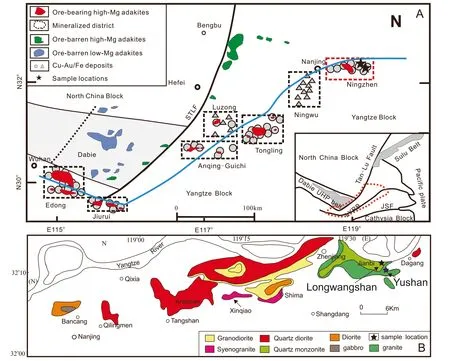
Fig.1 A simplified geological map of Lower Yangtze River Belt with 7 ore districts.B.Magmatic rocks in Ningzhen region with sample locations.Modified after (Wang et al.2014a, b)
Magmatic rocks cropped in eastern Ningzhen are called Jianbi pluton, which is composed of monzonite granite porphyry, quartz granite porphyry, and granite.Several samples of Jianbi pluton are collected from Yushan and Longwangshan county, Zhenjiang city.We named these samples YS and LWS plutons.The GPS location of Yushan rock is 32°09′27.9′′N, 119°34′23.0′′E and Longwangshan is 32°07′31.6′′N, 119°37′10.0′′E.Yushan pluton is granite porphyry, grayish-white to greenish-gray with unequal granular structure.The phenocryst minerals are quartz (10% in volume, 1 mm × 1.5 mm), plagioclase(7% in volume, 2 mm × 3 mm), biotite (~5% in volume), and a small amount of amphibole (<3% in volume).Accessory minerals are mainly composed of sphene,zircon,and apatite.The matrix minerals are plagioclase and quartz.The whole rock has slightly sericite alteration.Longwangshan pluton is mainly granite, which is grey,with a blocky structure.The main minerals are quartz(20%–25% in volume, 1 mm × 1.5-2 mm), plagioclase(45%–50% in volume, 2 mm × 3 mm), with few biotite and amphibole.The accessory minerals are magnetite,zircon, sphene, and apatite.These samples also suffered slight chlorite and sericite alteration (Fig.2).
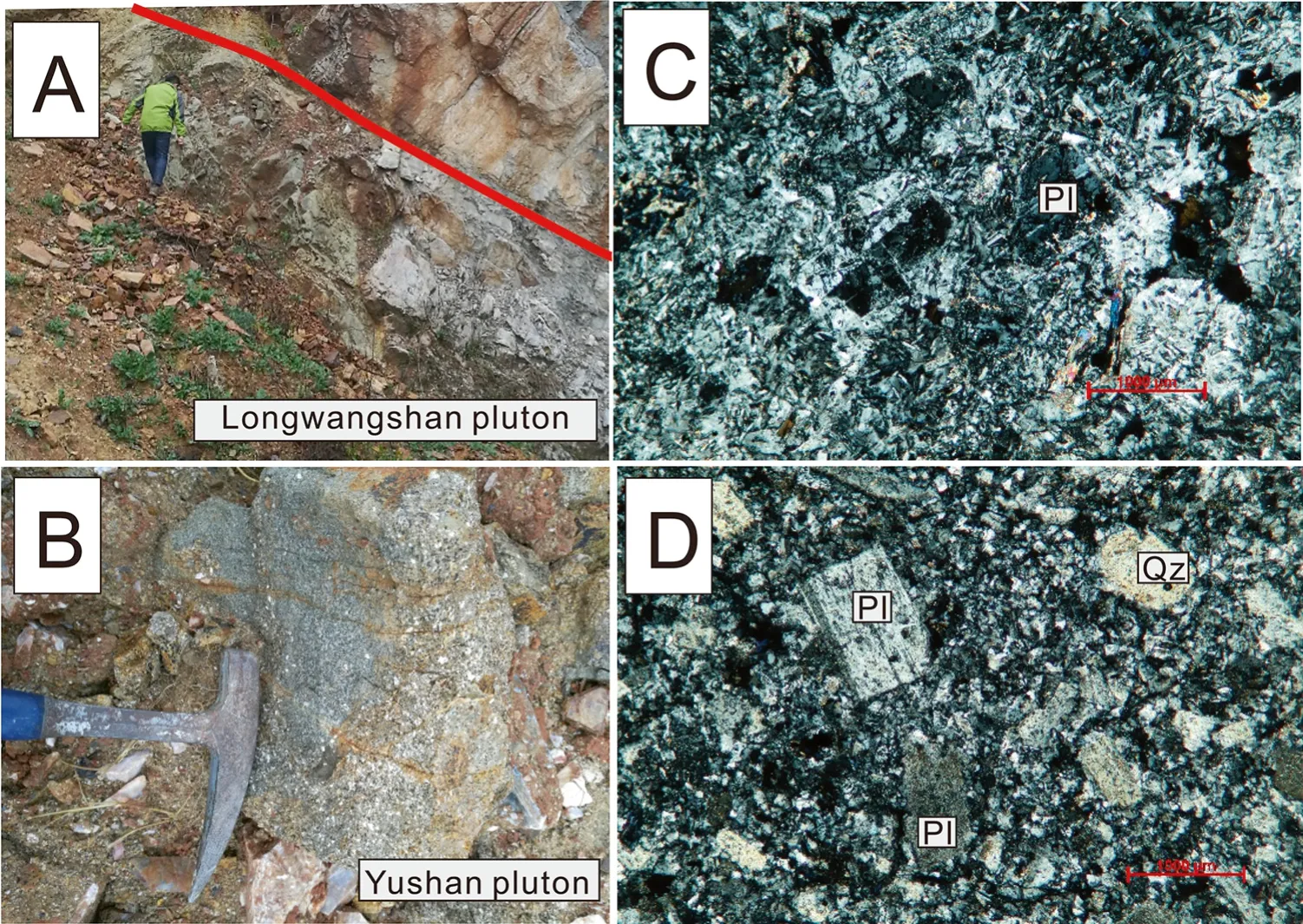
Fig.2 Represented hand specimens and microscope features of the thin section.Pl:plagioclase; Qtz: quartz
2 Analytical methods
Approximately 2 kg of each sample was sent to the Hongchuang Exploration Technology Service, Co.Ltd for zircon separation and CL image.Approximately 100–200 grains from each sample were mounted in an epoxy resin disc.Before the U-Th-Pb-Hf isotope analysis,all grains were documented with transmitted and reflected light microscopy,as well as cathodoluminescence(CL)imaging to reveal their internal structures.Tiny melt/fluid/apatite inclusions are commonly trapped in zircon and must be avoided during analysis.Zircon in situ U–Pb and trace elements were measured by Laser Ablation Inductively-Coupled Plasma Mass Spectrometry(LA-ICP-MS)at thein-situMineral Geochemistry Lab, Ore deposit and Exploration Centre (ODEC), Hefei University of Technology,China.The analyses were carried out on an Agilent 7900 Quadrupole ICP-MS coupled to a Photon Machines Analyte HE 193-nm ArF Excimer Laser Ablation system equipped.Ablation was performed in an atmosphere of UHP He(0.90 L/min),and upon exiting the cell the aerosol is mixed with Ar (0.85 L/min) immediately after the ablation cell.The ICP-MS system was optimized daily to maximize sensitivity on isotopes of the mass range of interest while keeping the production of molecular oxide species (i.e.,232Th16O/232Th) as low as possible, and usually <0.3%(Ning et al.2017;Wang et al.2017).Standard zircon 91,500 and SRM NIST 610 glass were used as external calibration for the U–Pb ages and trace element contents calculation,respectively.Zircon Plesˇovice(Sla′ma et al.2008) were analyzed between every 10 unknown samples for quality control.Each analysis began with a 20 s blank followed by a further 40 s analysis time after the laser was switched on.A laser beam of 30 μm in diameter was adopted at a repetition rate of 7 Hz and an energy density of 2.5 J/cm2.A flow rate of He carrier gas was set at 0.85 L/min.This gas carried ablated aerosol out of the sample chamber,then mixed with Ar gas and carried to the plasma torch.The off-line data processing was performed using a program called ICPMS Data Cal (Liu et al.2008).Time-dependent drifts of U-Th-Pb isotopic ratios were corrected using linear interpolation (with time) for every five analyses according to the variations of 91,500.Preferred U-Th-Pb isotopic ratios used for 91,500 are from Wiedenbeck et al.(1995).Uncertainty of preferred values for the external standard 91,500 was propagated to the ultimate results of the samples.Concordia diagrams and weighted mean calculations were made using Isoplot/Ex_ver 4.15 (Ludwig 2011).
Hafnium isotopic compositions of zircon were measured by the LA-MC-ICP-MS at the Isotope Laboratory at the School of Resources and Environmental Engineering,Hefei University of Technology.A Teledyne Cetac Technologies Analyte Excite laser-ablation system and ThermoFisher Neptune Plus MC-ICP-MS were combined for the experiments.A 193 nm ArF excimer laser was focused on the zircon surface with a fluence of ~3.0 J/cm2.The ablation protocol employed a spot diameter of 55 μm at a 7 Hz repetition rate for 30 s.A mixed gas of helium(~0.9 L/min)and argon(~0.9 L/min)was applied as the carrier gas to transport the aerosol to the MC-ICP-MS.Standard zircons (including Qinghu, Plesˇovice, and Penglai) were treated as quality control during the analytical process.All the data were reduced off-line with LAZrnHf-Calculator@HFUT (Gu et al.2019).Analytical results of176Hf/177Hf ratios for the three standard zircons Penglai,Plesˇovice and Qinghu measured in one batch experiment are 0.282915 ± 0.000019, 0.282484 ± 0.000007, and 0.282997 ± 0.000009,respectively,which agree very well with the reference values (reference ratios of176Hf/177Hf for Penglai, Plesˇovice and Qinghu are 0.282906 ± 0.000016, 0.282482 ± 0.000013 and 0.282996 ± 0.000044, respectively (Li et al.2013b; Li et al.2010b;Sla′ma et al.2008).The long-term monitoring of standard zircon’s initial176Hf/177Hf values was calculated based on a Lu decay constant of 1.865E-11(Scherer et al.2001).The model ages were calculated under the assumption that the176Lu/177Hf of the average crust is 0.015, and the176Hf/177Hf and176Lu/177Hf ratios of chondrite and depleted mantle at present are, respectively,0.282772 and 0.0332, and 0.28325 and 0.0384 (Blichert-Toft and Albare`de, 1997).
Whole-rock major and trace elements were analyzed in Nanjing FocuMS Technology Co.Ltd.The major elements were analyzed by the melting plate method and the test was completed by Axiosmax XRF(PANalytical B.V.)analysis.A detailed method of whole-rock trace elements analysis is as follows: about 40 mg rock powder with 0.5 mL nitric acid and 1.0 mL of hydrofluoric acid put in the polytetrafluoroethylene sample dissolving bomb.Then,the bomb is sealed by steel sleeve and put into the oven, and heated in the oven at 195 °C for 72 h to ensure that the sample is completely digested.The diluted digestion solution was analyzed by Agilent 7700 × ICP-MS.USGS geochemical standard (BIR-1, BHVO-2, BCR-2, AGV-2, RGM-2, and GSP-2) was used as quality control.The measured values of these geological standards are compared with GeoReM(Jochum and Nohl 2008);http://georem.mpch-mainz.gwdg.de): the deviation range of trace elements with a concentration greater than 10 × 10–6is not more than ± 10%;the deviation range of trace elements with a concentration greater than 50 × 10–6is not more than ± 5%.
3 Results
3.1 Zircon geochemistry
3.1.1 Zircon U–Pb ages and Hf isotopic compositions
Cathodoluminescence (CL) images from representative zircons from the Longwangshan and Yushan plutons are shown in Fig.3.The results of LA-ICP-MS U–Pb isotopic analysis for these samples are listed in Table 1 and shown in Fig.3.The zircon Lu–Hf isotopic results are given in Table 2.
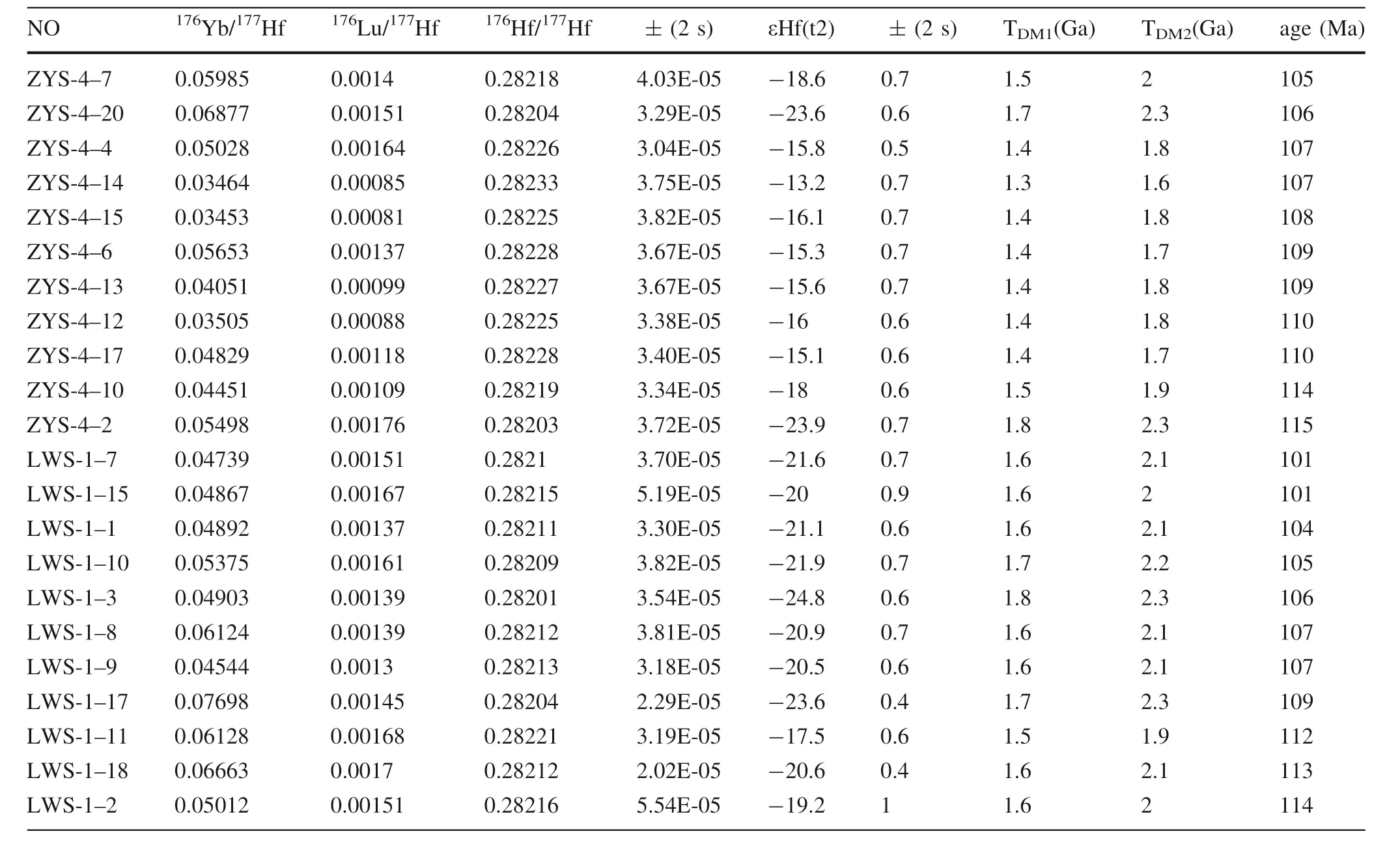
Table 2 Results of zircon Hf isotopes of magmatic rocks in the eastern Ningzhen
Zircon grains separated from these plutons are euhedral and prismatic, and approximately 150–250 μm in length with length/width ratios of 2:1–3:1 and show well-developed oscillatory zoning in CL images(Fig.3).Fourteen of 40 zircon of Longwangshan (LWS-1) have concordance greater than 80% with average206Pb/238U age of 108 Ma.These zircons have Th/U at ~0.71–1.32, indicating a magmatic origin for these zircons (Belousova et al.2002).Seven inherited zircon ages with a concordance greater than 85% are mainly distributed around 2.5 Ga.These younger groups of zircon grains yielded a range of initial176Hf/177Hf values (0.282008–0.282145) and εHf(t) values(- 24.8 to -7.5; Fig.4), corresponding to two-stage Hf model ages [TDM2(Hf)] of 1.9–2.3 Ga.
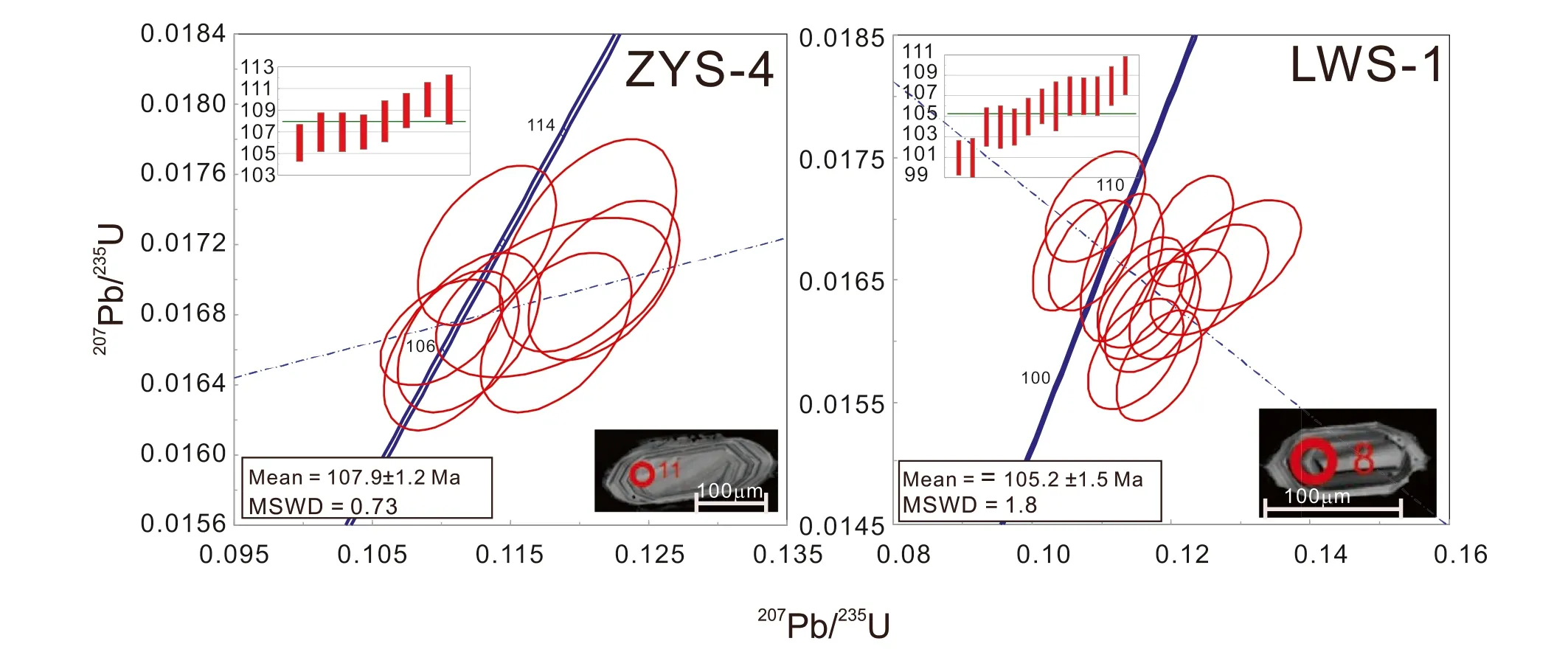
Fig.3 Zircon U–Pb isochron diagrams and weighted average 206Pb/238U ages of Yushan and Longwangshan pluton
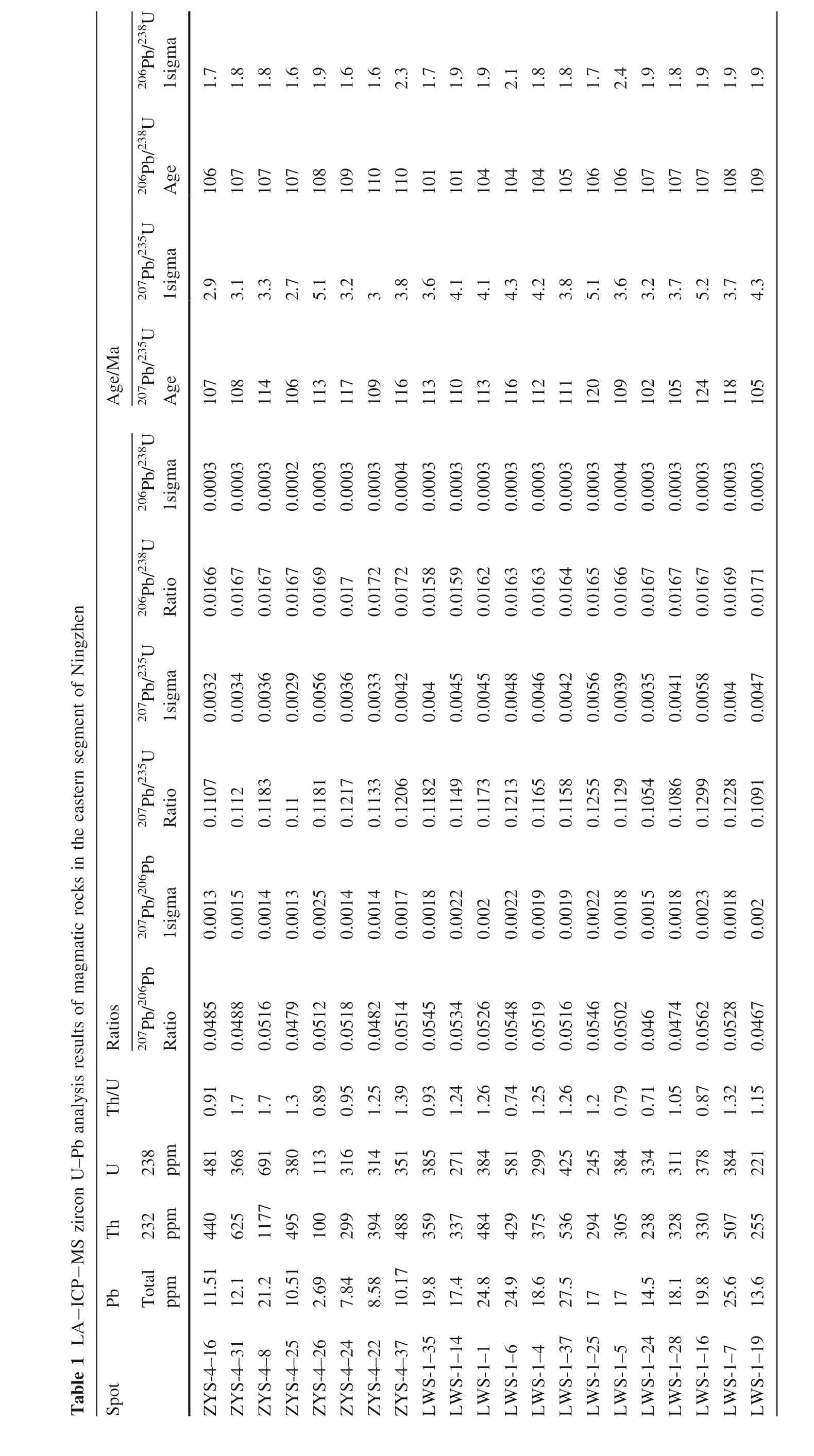
206Pb/238U 1sigma 206Pb/238U Age 207Pb/235U 1sigma 1.7 1.8 1.8 1.6 1.9 1.6 1.6 2.3 1.7 1.9 1.9 2.1 1.8 1.8 1.7 2.4 1.9 1.8 1.9 1.9 1.9 106 107 107 107 108 109 110 110 101 101 104 104 104 105 106 106 107 107 107 108 109 2.9 3.1 3.3 2.7 5.1 3.2 3 3.8 3.6 4.1 4.1 4.3 4.2 3.8 5.1 3.6 3.2 3.7 5.2 3.7 4.3 Age/Ma 207Pb/235U Age 107 108 114 106 113 117 109 116 113 110 113 116 112 111 120 109 102 105 124 118 105 206Pb/238U 1sigma 0.0003 0.0003 0.0003 0.0002 0.0003 0.0003 0.0003 0.0004 0.0003 0.0003 0.0003 0.0003 0.0003 0.0003 0.0003 0.0004 0.0003 0.0003 0.0003 0.0003 0.0003 Table 1 LA-ICP-MS zircon U–Pb analysis results of magmatic rocks in the eastern segment of Ningzhen Ratios Th/U U Th Pb Spot 206Pb/238U Ratio 207Pb/235U 1sigma 207Pb/235U Ratio 207Pb/206Pb 1sigma 207Pb/206Pb Ratio 238 ppm 232 ppm Total ppm 0.0166 0.0167 0.0167 0.0167 0.0169 0.017 0.0172 0.0172 0.0158 0.0159 0.0162 0.0163 0.0163 0.0164 0.0165 0.0166 0.0167 0.0167 0.0167 0.0169 0.0171 0.0032 0.0034 0.0036 0.0029 0.0056 0.0036 0.0033 0.0042 0.004 0.0045 0.0045 0.0048 0.0046 0.0042 0.0056 0.0039 0.0035 0.0041 0.0058 0.004 0.0047 0.1107 0.112 0.1183 0.11 0.1181 0.1217 0.1133 0.1206 0.1182 0.1149 0.1173 0.1213 0.1165 0.1158 0.1255 0.1129 0.1054 0.1086 0.1299 0.1228 0.1091 0.0013 0.0015 0.0014 0.0013 0.0025 0.0014 0.0014 0.0017 0.0018 0.0022 0.002 0.0022 0.0019 0.0019 0.0022 0.0018 0.0015 0.0018 0.0023 0.0018 0.002 0.0485 0.0488 0.0516 0.0479 0.0512 0.0518 0.0482 0.0514 0.0545 0.0534 0.0526 0.0548 0.0519 0.0516 0.0546 0.0502 0.046 0.0474 0.0562 0.0528 0.0467 0.91 1.7 1.7 1.3 0.89 0.95 1.25 1.39 0.93 1.24 1.26 0.74 1.25 1.26 1.2 0.79 0.71 1.05 0.87 1.32 1.15 481 368 691 380 113 316 314 351 385 271 384 581 299 425 245 384 334 311 378 384 221 440 625 1177 495 100 299 394 488 359 337 484 429 375 536 294 305 238 328 330 507 255 11.51 12.1 21.2 10.51 2.69 7.84 8.58 10.17 19.8 17.4 24.8 24.9 18.6 27.5 171714.5 18.1 19.8 25.6 13.6 ZYS-4–16 ZYS-4–31 ZYS-4–8 ZYS-4–25 ZYS-4–26 ZYS-4–24 ZYS-4–22 ZYS-4–37 LWS-1–35 LWS-1–14 LWS-1–1 LWS-1–6 LWS-1–4 LWS-1–37 LWS-1–25 LWS-1–5 LWS-1–24 LWS-1–28 LWS-1–16 LWS-1–7 LWS-1–19
Eleven of 40 zircons of Yushan (ZYS-4) have concordance greater than 80% with average206Pb/238U age of 106 Ma.These zircons have Th/U at 0.89–1.70.Eight inherited zircon ages with a concordance greater than 85%have wider ranges from 440 to 2400 Ma.These younger groups of zircon grains yielded a range of initial176Hf/177Hf values (0.282028–0.282338) and εHf(t) values(-23.9 to -12.6; Fig.4), corresponding to two-stage Hf model ages (TDM2(Hf)) of 1.6–2.3 Ga.
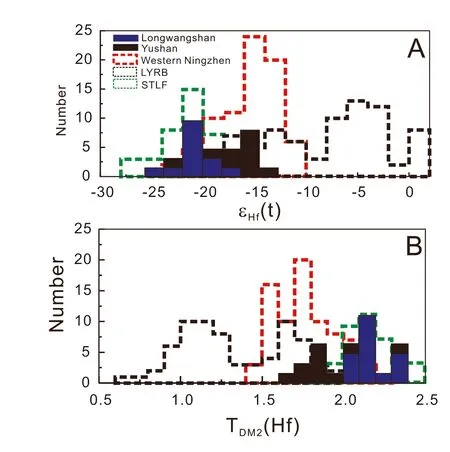
Fig.4 Zircon Hf isotopes of Yushan and Longwangshan pluton a and TDM2 ages b.Cited zircon Hf data are from Wang et al.(2014a, b)
Zircon Ce4+/Ce3+of Longwangshan and Yushan are 3–400 and 9–382,respectively.Comparing to zircons from western Ningzhen,LYRB,and STLF,zircons from eastern Ningzhen are similar to those from STLF, show low oxygen fugacity in their magma sources.
Ti-in-zircon thermometers of Longwangshan and Yushan are 640–776 °C and 637–794 °C, respectively.It was lower than those from STLF but similar to western Ningzhen (Wang et al.2014a, b), and slightly higher than those from LYRB (Wang et al.2013).
3.2 Whole-rock major and trace elements
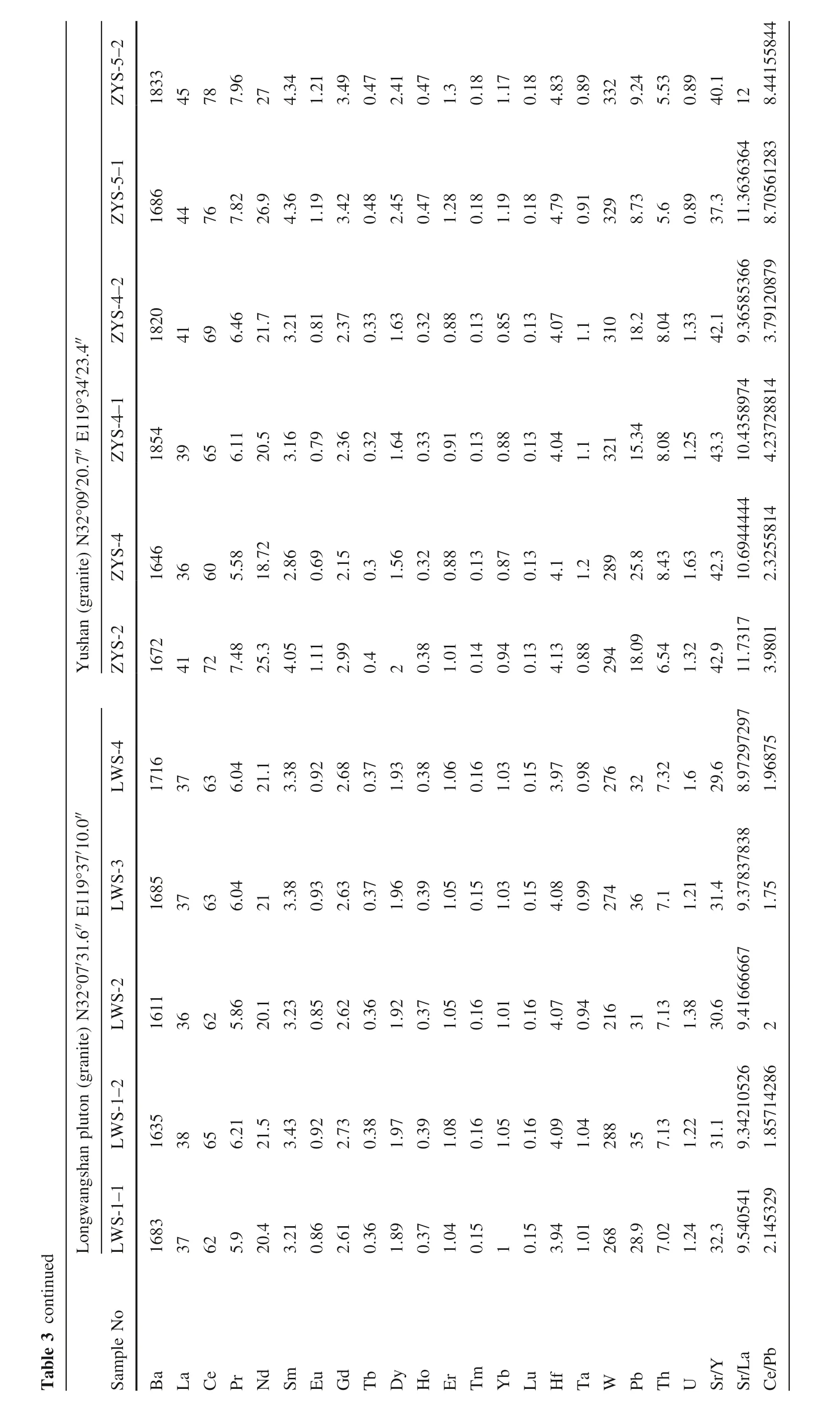
ZYS-5–2 ZYS-5–1 1833 45 78 7.96 27 4.34 1.21 3.49 0.47 2.41 0.47 1.3 0.18 1.17 0.18 4.83 0.89 332 9.24 5.53 0.89 40.1 12 8.44155844 1686 44 76 7.82 26.9 4.36 1.19 3.42 0.48 2.45 0.47 1.28 0.18 1.19 0.18 4.79 0.91 329 8.73 5.6 0.89 37.3 11.3636364 8.70561283 Table 3 continuedLongwangshan pluton (granite) N32°07′31.6′′ E119°37′10.0′′Yushan (granite) N32°09′20.7′′ E119°34′23.4′′ZYS-4–2 ZYS-4–1 ZYS-4 ZYS-2 LWS-4 LWS-3 LWS-2 LWS-1–2 LWS-1–1 Sample No 1820 41 69 6.46 21.7 3.21 0.81 2.37 0.33 1.63 0.32 0.88 0.13 0.85 0.13 4.07 1.1 310 18.2 8.04 1.33 42.1 9.36585366 3.79120879 1854 39 65 6.11 20.5 3.16 0.79 2.36 0.32 1.64 0.33 0.91 0.13 0.88 0.13 4.04 1.1 321 15.34 8.08 1.25 43.3 10.4358974 4.23728814 1646 36605.58 18.72 2.86 0.69 2.15 0.3 1.56 0.32 0.88 0.13 0.87 0.13 4.1 1.2 289 25.8 8.43 1.63 42.3 10.6944444 2.3255814 1672 41727.48 25.3 4.05 1.11 2.99 0.4 20.38 1.01 0.14 0.94 0.13 4.13 0.88 294 18.09 6.54 1.32 42.9 11.7317 3.9801 1716 37636.04 21.1 3.38 0.92 2.68 0.37 1.93 0.38 1.06 0.16 1.03 0.15 3.97 0.98 276 327.32 1.6 29.6 8.97297297 1.96875 1685 37 63 6.04 21 3.38 0.93 2.63 0.37 1.96 0.39 1.05 0.15 1.03 0.15 4.08 0.99 274 36 7.1 1.21 31.4 9.37837838 1.75 1611 36 62 5.86 20.1 3.23 0.85 2.62 0.36 1.92 0.37 1.05 0.16 1.01 0.16 4.07 0.94 216 31 7.13 1.38 30.6 9.41666667 2 1635 38 65 6.21 21.5 3.43 0.92 2.73 0.38 1.97 0.39 1.08 0.16 1.05 0.16 4.09 1.04 288 35 7.13 1.22 31.1 9.34210526 1.85714286 1683 37 62 5.9 20.4 3.21 0.86 2.61 0.36 1.89 0.37 1.04 0.15 1 0.15 3.94 1.01 268 28.9 7.02 1.24 32.3 9.540541 2.145329 Ba La Ce Pr Nd Sm Eu Gd Tb Dy Ho Er Tm Yb Lu Hf Ta WPb Th USr/Y Sr/La Ce/Pb
Whole-rock major and trace elements and sample GPS locations were listed in Table 3.The samples from eastern Ningzhen have high SiO2(68.60–73.99 wt.%), Na2O(3.37–4.25 wt.%), MgO (0.72–1.79 wt.%), Al2O3(13.56–16.47 wt.%), and high Mg#(47–55).These rocks are mainly in the granodiorite and granite areas in the TAS diagram(Fig.5a)and belong to the high silicon aluminumrich calc-alkaline rocks.In the SiO2-K2O diagram(Fig.5b), the samples fall into the region of the high-K calcium alkaline series.In the A/CNK-A/NK diagram(Fig.5c), the samples fall in the metaluminous areas.The negative correlations between major elements (Fe2O3,CaO,Al2O3,TiO2,and P2O5)and SiO2(Fig.6),suggesting a fractionation crystallization(FC)in the magma chamber.For trace elements,these rocks have light REE enrichment and heavy REE depletion in REE diagram.These samples are rich in large ion lithophile elements (LILE) (e.g., Sr,Ba, Pb) and deplete high field strength elements(HFSE)(e.g., Nb, Ta, Ti), similar to a continental crust.These rocks have high Sr (338–540 ppm), low Yb(0.85–1.85 ppm) and Y (9.08–13.47 ppm), and slightly negative Eu anomaly (0.82–0.93), which is similar to adakite (Fig.7).
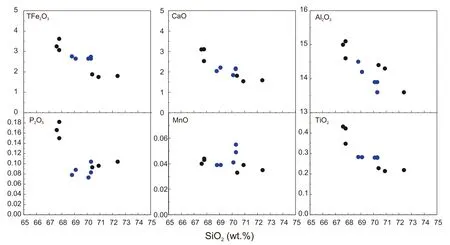
Fig.6 Hark diagram of major elements of Longwangshan and Yushan plutons
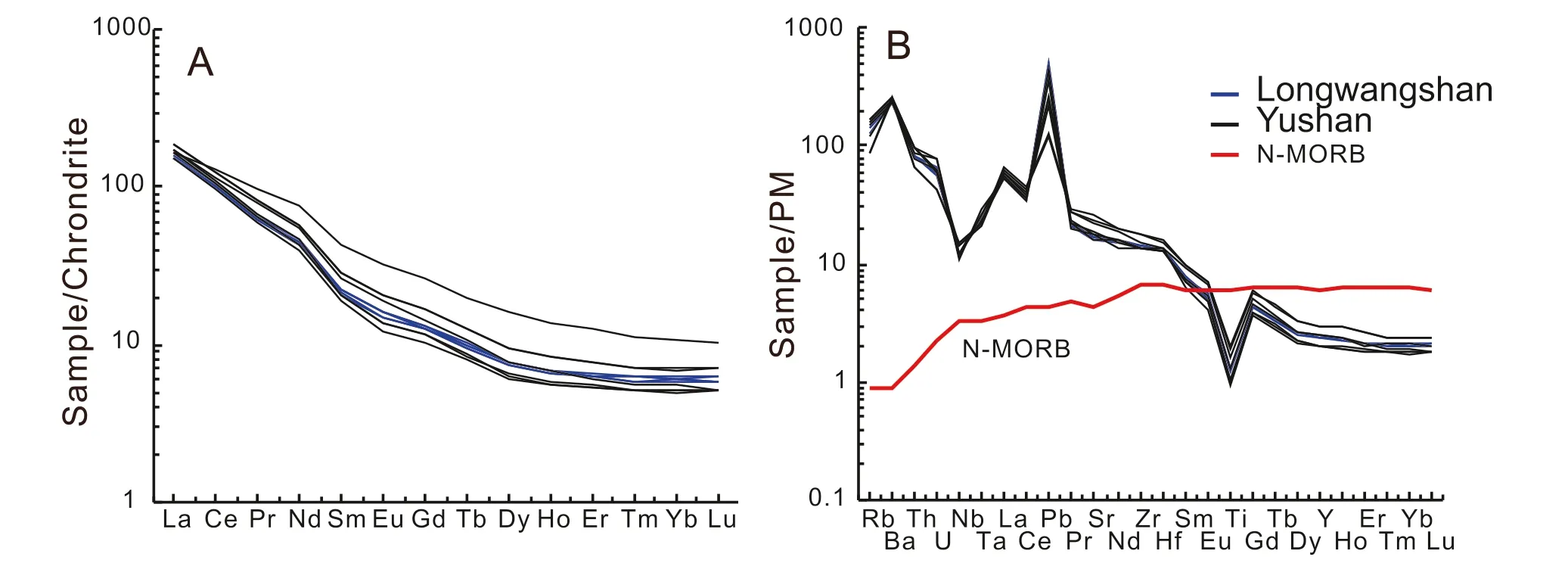
Fig.7 Chondrite normalized rare earth element patterns a and primitive mantle normalized trace element patterns b for Longwangshan and Yushan plutons.The normalizing values are from Sun and McDonough (1989).N-MORB is from Sun and McDonough (1989)
4 Discussions
4.1 Time of the magmatic rocks in Ningzhen region
Like the convenience of the high-quality dating method,lots of age results were reported in the Ningzhen region(Table 4).The age framework of magmatic-metallogenic events in the Ningzheng region is determined.But these ages are mainly focused in the western Ningzhen region.The published ages are concentrated in 100–110 Ma.But some intermediate-basic rocks in the westmost Ningzhen region were reported at 124–120 Ma (Liu et al.2019; Lu et al.2019a, b), e.g., Jiangmiao gabbro, pyroxene diorite near Nanjing City, Qilingmen granite porphyry in western Nanjing City.The ages of the ore deposits in the Ningzhen region are also similar to magmatic ages.Wang et al.(1997) get molybdenite Re-Os ages of Tongshan(106 ± 3 Ma)and Anjishan(108 ± 2 Ma).The Ar–Ar age of phlogopite of Citoushan iron deposit is 104 Ma.These ore deposits are temporarily and spatially associated with magmatic rocks in this region (Sun et al.2013a, b).The Longwanshan and Yushan pluton,in the eastern part of the Ningzhen region, were also formed at 108–107 Ma, in accordance with the time of magmatic rocks in western Ningzhen.Combined with published data, the main magmatic and metallogenic activity in the Ningzhen region is mainly in 110 ± 10 Ma, obviously younger than other areas in LYRB.
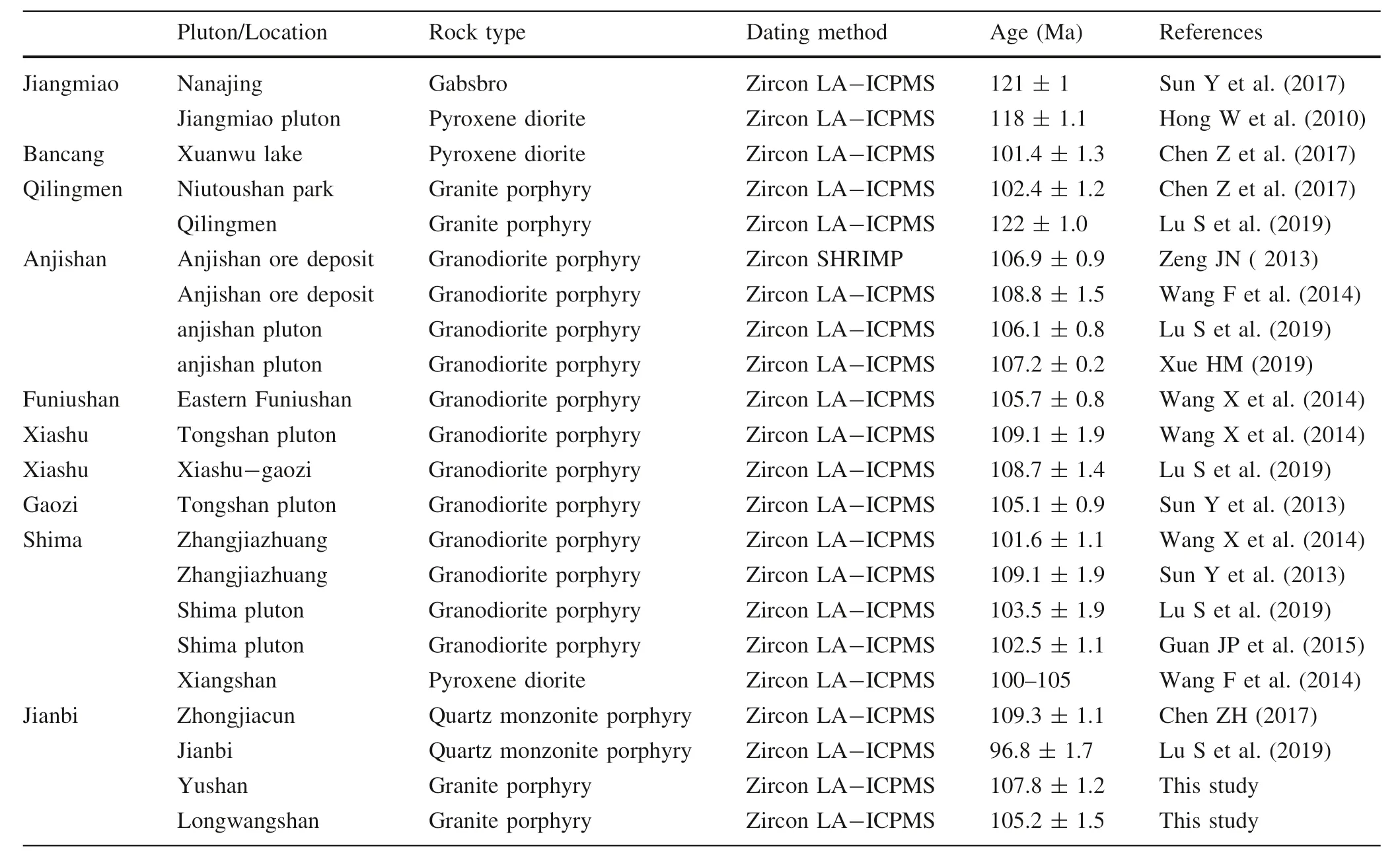
Table 4 Statistical table of diagenetic age of magmatic rocks in Ningzhen area
4.2 Petrogenesis of the high Sr/Y granitic magma in eastern Ningzhen
Whole-rock major and trace elements show that the magmatic rocks in eastern Ningzhen are with typical adakitic features, such as high Sr/Y, high Al2O3,and low Yb.The high Mg# of the rocks also indicates a mafic component involvement in their magma sources.Several models were proposed for high Mg# adaktic rocks in LYRB: 1.Melts from the subducted oceanic crust (Deng et al.2016; Ling et al.2009, 2011; Liu et al.2010; Wang et al.2013; Yang et al.2014);2.Fractionation and crystallization(FC)of the melts from the metasomatized mantle (Li et al.2013a;Wang et al.2016; Xie et al.2011); 3.Magma mixing between melt from the ancient lower continental crust and metasomatized mantle wedge (Wang et al.2014a, b); 4.Delamination of ancient lower continental crust (Wang et al.2006; Xu et al.2002; Xue 2019).
The model of partial melting of the subducted oceanic crust could be eluded firstly.The studied samples are enriched in Al2O3, K2O (3.14–4.33 wt.%), relatively low Na2O/K2O (0.82–1.19), which is lower than that from subducted oceanic crust.Zircon Hf isotope of the eastern Ningzhen magma is highly enriched (-24.8 ~-3.2),which is also different from oceanic crust.The geochemical features also ruled out the Model 2(FC model)because oceanic crust and mantle sources usually have positive Hf isotopic values.
Whole-rock geochemistry and zircon U–Pb ages with Hf isotopes of eastern Ningzhen pluton indicate an ancient lower continental crust in their sources.In K2O/Na2O vs Al2O3diagram, samples from eastern Ningzhen fall into the region of the high Mg# adaktic rock from the STLF(Fig.8).Meanwhile, they have similar Th/U to averaged continental crust and low Ce/Pb (4–5) and Sr/La (<20)(Fig.9), which are also similar to the STLF high Mg#adakitic rock.Zircon Hf isotopes are also similar to those from the STLF indicating a major contribution of the ancient continental crust of North China Craton to the magma source (Fig.4).The inherited residual zircons are mainly falling 1.8–2.5 Ga, which are similar to the main forming ages of North China Craton.Few Caledonian zircon ages were also found in Yushan pluton may indicate some involvement of South China Block materials.
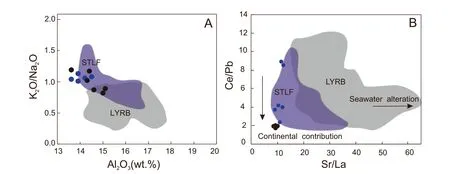
Fig.8 Whole-rock K2O/Na2O versus Al2O3 diagram a.Whole-rock Ce/Pb versus Sr/La diagram.Data sources are from Liu et al.(2010)
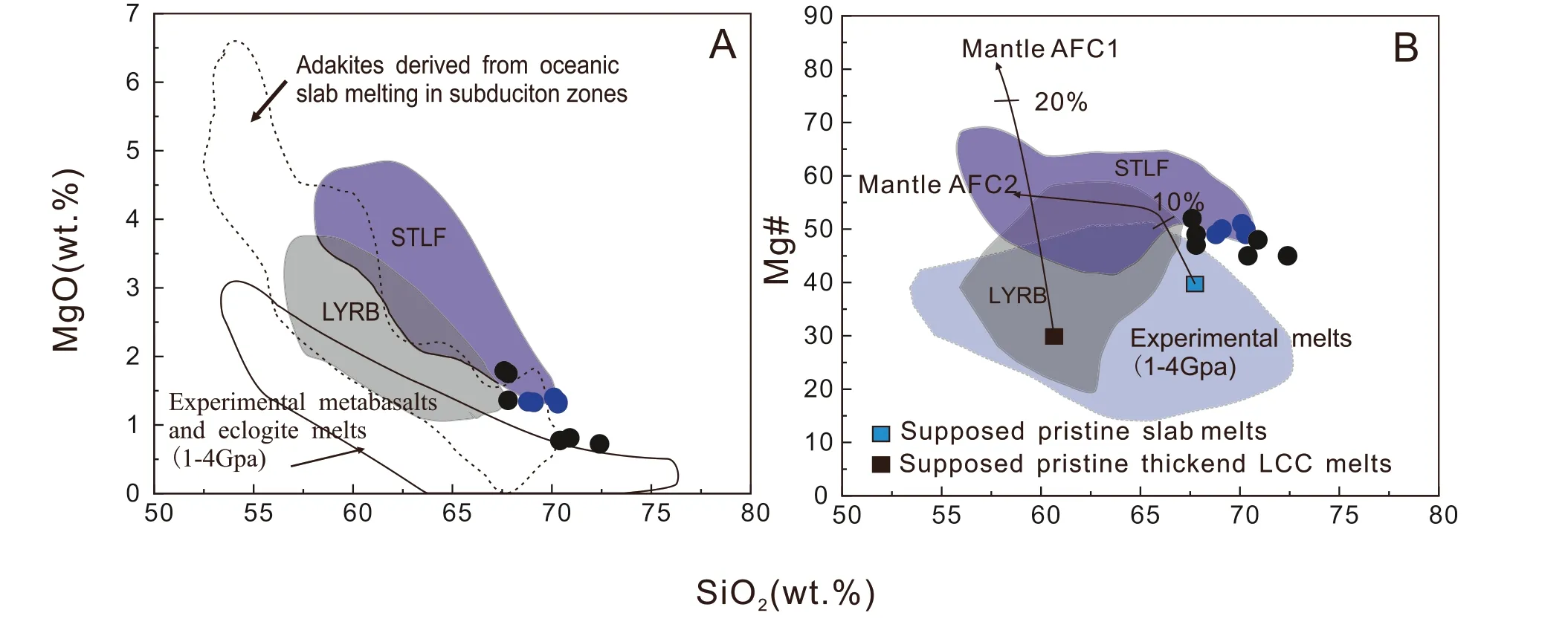
Fig.9 Whole-rock MgO a and Mg# b versus SiO2 diagram.Data sources are from Liu et al.(2010 and references therein)
Melts from thickened mafic lower crustal usually have low Mg# (<40) (He et al.2011; Xu et al.2002).But the eastern Ningzhen pluton has high Mg# (average ~50.7)and high Cr (average ~30 ppm), which strongly suggest a mafic magma in their sources(Liu et al.2010).The mafic microgranular enclaves (MMEs) have been reported from the western Ningzhen region, such as Anjishan, Tognshan plutons (Wang et al.2014a, b).But the loss of MMEs in our studied plutons may indicate fewer mafic endmember in the eastern Ningzhen than the western Ningzhen.
Zircon trace element features (Ce4+/Ce3+and δEu) of eastern Ningzhen plutons are similar to those from STLF but different to the western Ningzhen and other older adakitic rocks in LYRB(Fig.10).The low Ce4+/Ce3+and δEu of eastern Ningzhen indicated low oxygen fugacity and lower water contents in their magma sources(Fig.10).
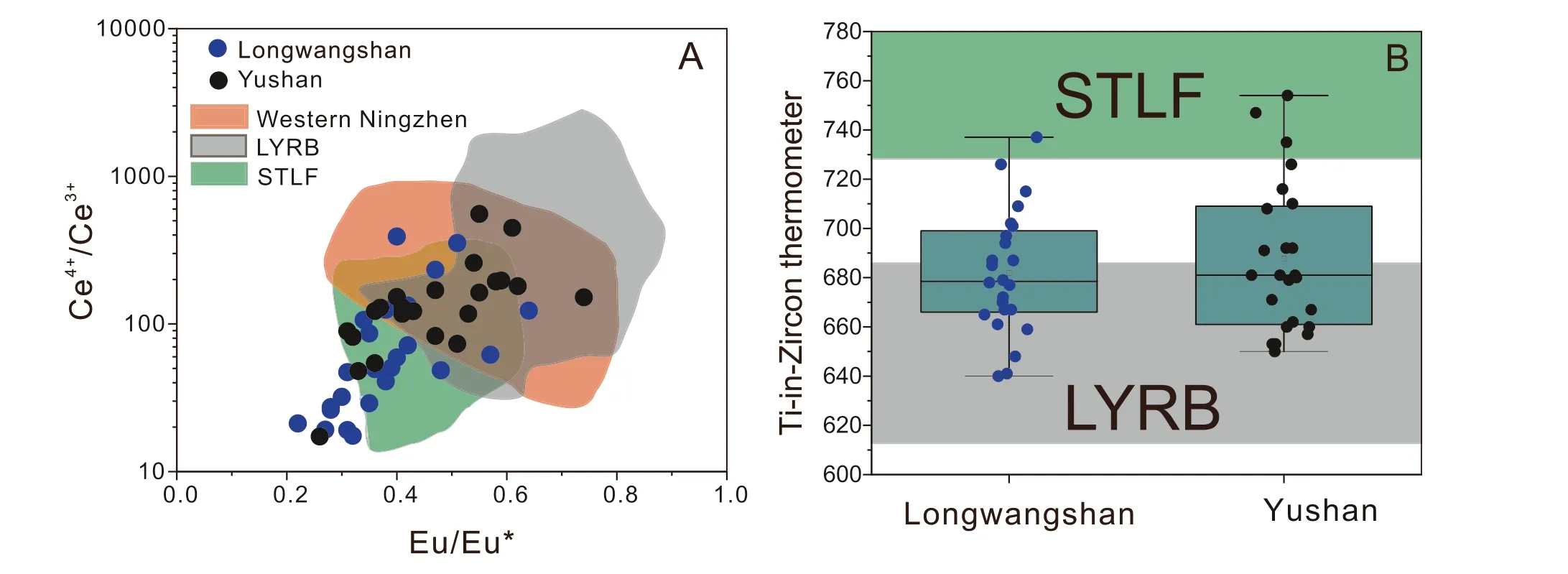
Fig.10 Zircon Ce4 + /Ce3 + versus Eu/Eu*diagram a and Ti-in-zircon thermometer diagram b.Data are from Wang et al.(2013; 2014a, b)
In sum,the magmatic rocks from eastern Ningzheng are similar to those from STLF(Gu et al.2013;He et al.2011),but there still are some differences between them: (1)Eastern Ningzhen magma have evolved SiO2and low MgO and TFe2O3than those from the STLF;(2)Magma activity in Ningzhen is younger than the STLF.
Model 3 and Model 4 are not easy to differentiate here.However, considering the neighborhood of eastern Ningzhen and western Ningzhen and the same forming ages, the magma mixing model is preferred here to explain the origin of the eastern Ningzhen magma.
4.3 Metallogenesis differences between eastern and western Ningzhen
The high oxygen fugacity is in favor of Cu mineralization because of the release of Cu to melts due to the breakdown of mantle sulfide minerals(Dilles et al.2015;Sillitoe 1997;Tang et al.2020b).The porphyry Cu deposits with adakitic rocks usually occurred along subduction zone around the world with high oxygen fugacity (Shen et al.2015;Thie′blemont et al.1997).However, W-Mo deposits are usually related to the continental crustal sources with low oxygen fugacity (Candela and Bouton 1990).Ningzhen metallogenic ore district has W–Mo–Cu–Fe–Pb–Zn deposits with an east–west trend.According to the deposits’ geological positions, the Cu–Fe–Pb–Zn deposits are mainly in the western Ningzhen, but W-Mo ore spots are distributed in the eastern Ningzhen.The differences in ore type may indicate different magma sources with different redox states (Wang et al.2014a, b), e.g., the western part has higher fO2and more mantle components in their magma sources and the eastern part has lower fO2and more crustal materials.These differences are consistent with the whole rock geochemical and zircon Ce4+/Ce3+and δEu features in the ore-related rocks (Fig.8).
4.4 Tectonic setting of Ningzhen region, eastern China
It is accepted that Eastern China was under the subduction of the paleo-Pacific plate during the Mesozoic (Li et al.2019; Li et al.2010a; Li and Li 2007; Wang et al.2011, 2014a, b; Zhou and Li 2000).But for the tectonics setting of the LYRB and nearby region is still under debate,especially in the Ningzhen region.At least, three different models have been proposed.The crustal delamination model (Xu et al.2002; Xue 2019) proposed that the Ningzhen region,even the LYRB(Wang et al.2006),has a thickened lower continental crust (>40 km).But according to the geochemical differences between LYRB adakitic rocks and the Ningzhen adakitic rocks (Liu et al.2010;Wang et al.2013), the magma from the Ningzhen region maybe from mixing of melt from the lower continental crust and metasomatized mantle, and the other adakitic rocks from the LYRB are from slab melts (Wang et al.2014a, b).The Ridge subduction model was also proposed by Ling et al.(2009)according to the drifting history of the paleo-Pacific plate and rock association in LYRB.Meanwhile, the flat subduction model was proposed by several researchers(Li et al.2013a;Wang et al.2014a,b;Wu et al.2012; Yang et al.2014).Most of the models mentioned above were established mostly based on 145–125 Ma magmatic rocks in LYRB.Recently, many zircon U–Pb dating results show that the Ningzhen region has a new period of magmatism of the LYRB (100–100 Ma), while the tectonic setting of this region hasn’t been well discussed.Two models were proposed here.Wang et al.(2014a, b) proposed a slab roll-back model, by complicating the magma association, geochemical properties,time and space distribution along the LYRB.Another model is the delamination model based on the high Mg#adakitic rocks with low radiogenic Pb signatures(Xu et al.2002; Xue 2019).
Here we found that the whole-rock geochemical and zircon geochemistry of the eastern Ningzhen magmatic rocks showed contract to those in western Ningzhen.These rocks usually have lower oxygen fugacity and lower water content in their magma sources.These features are similar to those from the delaminated lower continental crust.However, it is difficult to combine these two models to explain the geological and geochemical features we found.Here we proposed a plausible model to address this feature under the tectonic background of the paleo-Pacific subduction.
The Ningzhen region in the eastern part of the LYRB,which is in front of the subduction zone.When the slab rolled back, the angle of the subducted paleo-Pacific plate would become larger, increasing the lateral pressure and thickened the lithosphere.This process may influence the continental crust and the lithosphere mantle in the front region.Though the crustal thickness is not easy to constrain, it is proposed here that the eastern Ningzhen region may have a thicker crust than the western Ningzhen region according to the differences between eastern Ningzhen and western Ningzhen.The geochemical difference between them may be caused by the thickness of the continental crust.The high-angle subduction of the paleo-Pacific plate might cause metasomatized mantle and lower continental crustal melting (Fig.11) (Wang et al.2014a, b).The different mixing ratios of mantle components would lead to the geochemical difference of the related magmatic rocks.Finally, these differences might be responsible for the ore mineralization in the Ningzhen region.
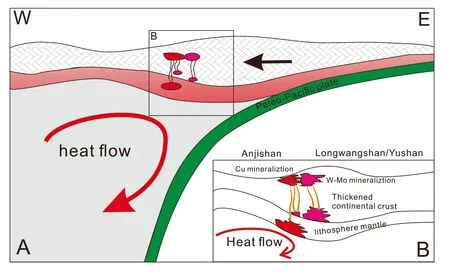
Fig.11 Tectonic Model for magmatic rocks in the Ningzhen region
5 Conclusions
Magmatic rocks in eastern Ningzhen were studied here and by comparing all the published data we found:
1.Magmatic rocks in Eastern Ningzhen were formed at 100–110 Ma, similar to previously published zircon U–Pb ages, indicating a new stage of magmatism.
2.The magma from eastern Ningzhen is mainly from thickened ancient lower continental crust with a small amount of mantle magma.
3.The whole-rock geochemistry, zircon geochemistry,and ore-type differences between eastern Ningzhen and western Ningzhen indicating different continental sources.
4.These differences may be induced by the high-angle subduction of the paleo-Pacific plate.
Appendix1
Zircon trace elements contents and calculated Ce, Eu, Tiin-zircon and fO2.
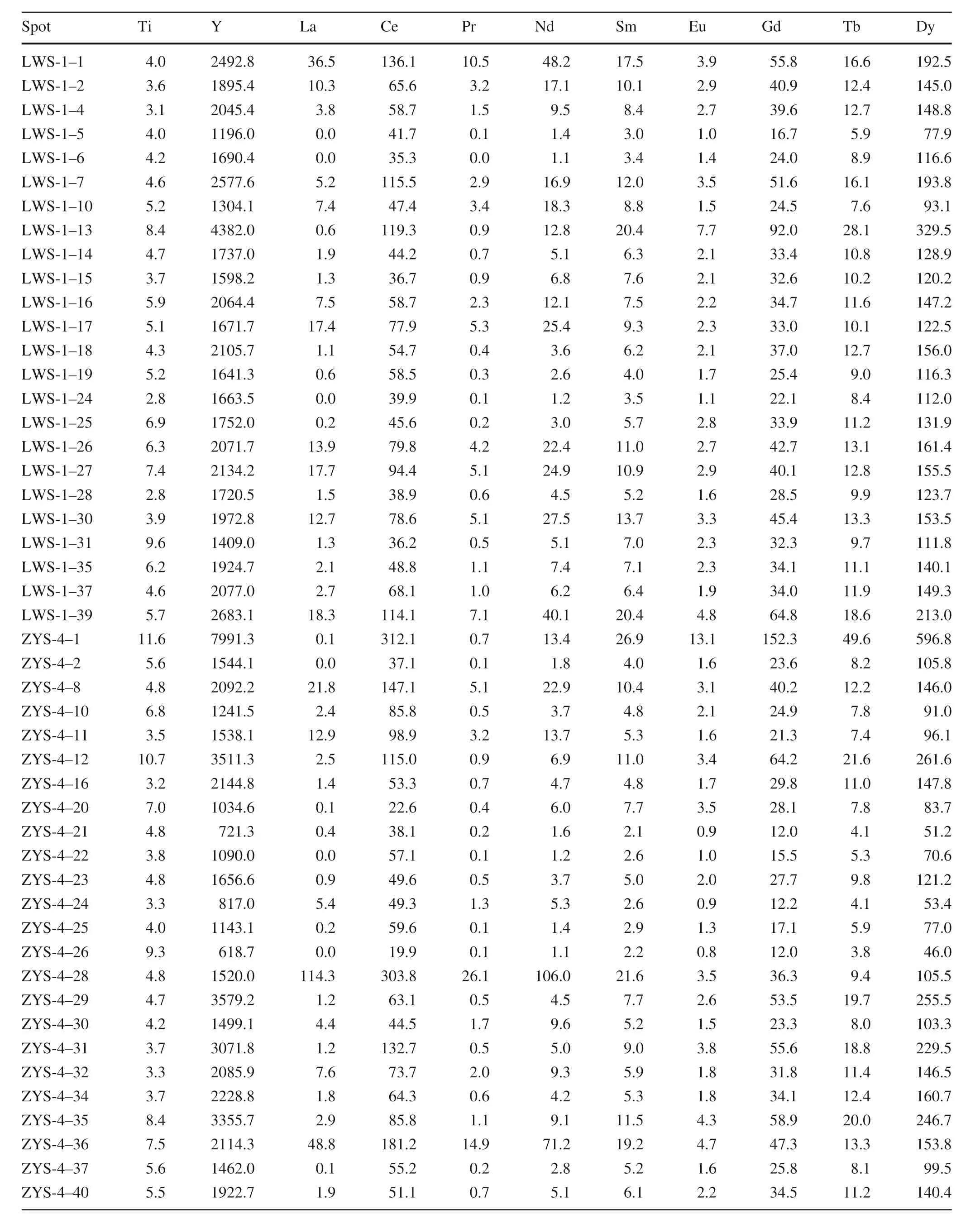
Spot Ti Y La Ce Pr Nd Sm Eu Gd Tb Dy LWS-1–1 4.0 2492.8 36.5 136.1 10.5 48.2 17.5 3.9 55.8 16.6 192.5 LWS-1–2 3.6 1895.4 10.3 65.6 3.2 17.1 10.1 2.9 40.9 12.4 145.0 LWS-1–4 3.1 2045.4 3.8 58.7 1.5 9.5 8.4 2.7 39.6 12.7 148.8 LWS-1–5 4.0 1196.0 0.0 41.7 0.1 1.4 3.0 1.0 16.7 5.9 77.9 LWS-1–6 4.2 1690.4 0.0 35.3 0.0 1.1 3.4 1.4 24.0 8.9 116.6 LWS-1–7 4.6 2577.6 5.2 115.5 2.9 16.9 12.0 3.5 51.6 16.1 193.8 LWS-1–10 5.2 1304.1 7.4 47.4 3.4 18.3 8.8 1.5 24.5 7.6 93.1 LWS-1–13 8.4 4382.0 0.6 119.3 0.9 12.8 20.4 7.7 92.0 28.1 329.5 LWS-1–14 4.7 1737.0 1.9 44.2 0.7 5.1 6.3 2.1 33.4 10.8 128.9 LWS-1–15 3.7 1598.2 1.3 36.7 0.9 6.8 7.6 2.1 32.6 10.2 120.2 LWS-1–16 5.9 2064.4 7.5 58.7 2.3 12.1 7.5 2.2 34.7 11.6 147.2 LWS-1–17 5.1 1671.7 17.4 77.9 5.3 25.4 9.3 2.3 33.0 10.1 122.5 LWS-1–18 4.3 2105.7 1.1 54.7 0.4 3.6 6.2 2.1 37.0 12.7 156.0 LWS-1–19 5.2 1641.3 0.6 58.5 0.3 2.6 4.0 1.7 25.4 9.0 116.3 LWS-1–24 2.8 1663.5 0.0 39.9 0.1 1.2 3.5 1.1 22.1 8.4 112.0 LWS-1–25 6.9 1752.0 0.2 45.6 0.2 3.0 5.7 2.8 33.9 11.2 131.9 LWS-1–26 6.3 2071.7 13.9 79.8 4.2 22.4 11.0 2.7 42.7 13.1 161.4 LWS-1–27 7.4 2134.2 17.7 94.4 5.1 24.9 10.9 2.9 40.1 12.8 155.5 LWS-1–28 2.8 1720.5 1.5 38.9 0.6 4.5 5.2 1.6 28.5 9.9 123.7 LWS-1–30 3.9 1972.8 12.7 78.6 5.1 27.5 13.7 3.3 45.4 13.3 153.5 LWS-1–31 9.6 1409.0 1.3 36.2 0.5 5.1 7.0 2.3 32.3 9.7 111.8 LWS-1–35 6.2 1924.7 2.1 48.8 1.1 7.4 7.1 2.3 34.1 11.1 140.1 LWS-1–37 4.6 2077.0 2.7 68.1 1.0 6.2 6.4 1.9 34.0 11.9 149.3 LWS-1–39 5.7 2683.1 18.3 114.1 7.1 40.1 20.4 4.8 64.8 18.6 213.0 ZYS-4–1 11.6 7991.3 0.1 312.1 0.7 13.4 26.9 13.1 152.3 49.6 596.8 ZYS-4–2 5.6 1544.1 0.0 37.1 0.1 1.8 4.0 1.6 23.6 8.2 105.8 ZYS-4–8 4.8 2092.2 21.8 147.1 5.1 22.9 10.4 3.1 40.2 12.2 146.0 ZYS-4–10 6.8 1241.5 2.4 85.8 0.5 3.7 4.8 2.1 24.9 7.8 91.0 ZYS-4–11 3.5 1538.1 12.9 98.9 3.2 13.7 5.3 1.6 21.3 7.4 96.1 ZYS-4–12 10.7 3511.3 2.5 115.0 0.9 6.9 11.0 3.4 64.2 21.6 261.6 ZYS-4–16 3.2 2144.8 1.4 53.3 0.7 4.7 4.8 1.7 29.8 11.0 147.8 ZYS-4–20 7.0 1034.6 0.1 22.6 0.4 6.0 7.7 3.5 28.1 7.8 83.7 ZYS-4–21 4.8 721.3 0.4 38.1 0.2 1.6 2.1 0.9 12.0 4.1 51.2 ZYS-4–22 3.8 1090.0 0.0 57.1 0.1 1.2 2.6 1.0 15.5 5.3 70.6 ZYS-4–23 4.8 1656.6 0.9 49.6 0.5 3.7 5.0 2.0 27.7 9.8 121.2 ZYS-4–24 3.3 817.0 5.4 49.3 1.3 5.3 2.6 0.9 12.2 4.1 53.4 ZYS-4–25 4.0 1143.1 0.2 59.6 0.1 1.4 2.9 1.3 17.1 5.9 77.0 ZYS-4–26 9.3 618.7 0.0 19.9 0.1 1.1 2.2 0.8 12.0 3.8 46.0 ZYS-4–28 4.8 1520.0 114.3 303.8 26.1 106.0 21.6 3.5 36.3 9.4 105.5 ZYS-4–29 4.7 3579.2 1.2 63.1 0.5 4.5 7.7 2.6 53.5 19.7 255.5 ZYS-4–30 4.2 1499.1 4.4 44.5 1.7 9.6 5.2 1.5 23.3 8.0 103.3 ZYS-4–31 3.7 3071.8 1.2 132.7 0.5 5.0 9.0 3.8 55.6 18.8 229.5 ZYS-4–32 3.3 2085.9 7.6 73.7 2.0 9.3 5.9 1.8 31.8 11.4 146.5 ZYS-4–34 3.7 2228.8 1.8 64.3 0.6 4.2 5.3 1.8 34.1 12.4 160.7 ZYS-4–35 8.4 3355.7 2.9 85.8 1.1 9.1 11.5 4.3 58.9 20.0 246.7 ZYS-4–36 7.5 2114.3 48.8 181.2 14.9 71.2 19.2 4.7 47.3 13.3 153.8 ZYS-4–37 5.6 1462.0 0.1 55.2 0.2 2.8 5.2 1.6 25.8 8.1 99.5 ZYS-4–40 5.5 1922.7 1.9 51.1 0.7 5.1 6.1 2.2 34.5 11.2 140.4
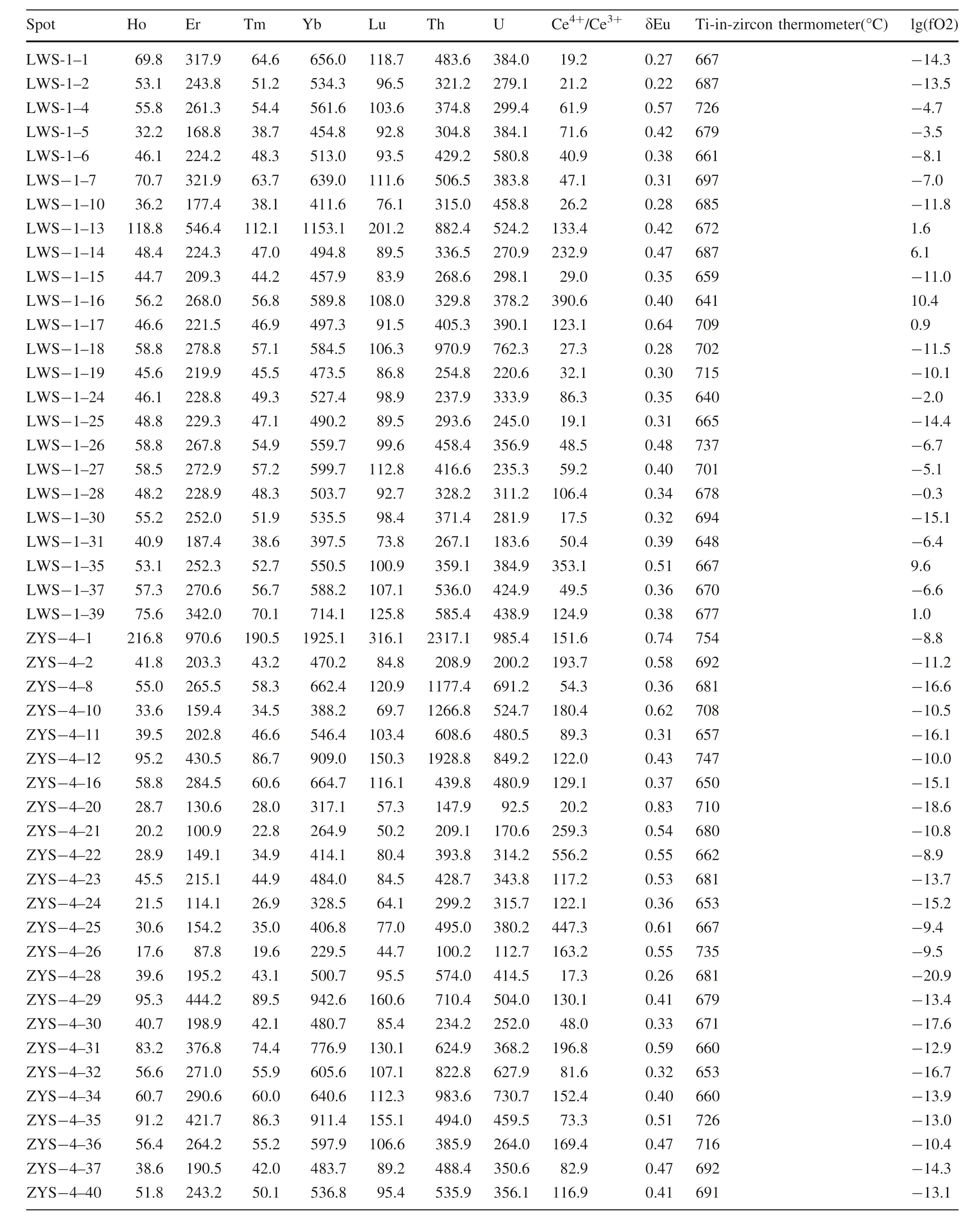
Spot Ho Er Tm Yb Lu Th U Ce4+/Ce3+ δEu Ti-in-zircon thermometer(°C) lg(fO2)LWS-1–1 69.8 317.9 64.6 656.0 118.7 483.6 384.0 19.2 0.27 667 -14.3 LWS-1–2 53.1 243.8 51.2 534.3 96.5 321.2 279.1 21.2 0.22 687 -13.5 LWS-1–4 55.8 261.3 54.4 561.6 103.6 374.8 299.4 61.9 0.57 726 -4.7 LWS-1–5 32.2 168.8 38.7 454.8 92.8 304.8 384.1 71.6 0.42 679 -3.5 LWS-1–6 46.1 224.2 48.3 513.0 93.5 429.2 580.8 40.9 0.38 661 -8.1 LWS-1–7 70.7 321.9 63.7 639.0 111.6 506.5 383.8 47.1 0.31 697 -7.0 LWS-1–10 36.2 177.4 38.1 411.6 76.1 315.0 458.8 26.2 0.28 685 -11.8 LWS-1–13 118.8 546.4 112.1 1153.1 201.2 882.4 524.2 133.4 0.42 672 1.6 LWS-1–14 48.4 224.3 47.0 494.8 89.5 336.5 270.9 232.9 0.47 687 6.1 LWS-1–15 44.7 209.3 44.2 457.9 83.9 268.6 298.1 29.0 0.35 659 -11.0 LWS-1–16 56.2 268.0 56.8 589.8 108.0 329.8 378.2 390.6 0.40 641 10.4 LWS-1–17 46.6 221.5 46.9 497.3 91.5 405.3 390.1 123.1 0.64 709 0.9 LWS-1–18 58.8 278.8 57.1 584.5 106.3 970.9 762.3 27.3 0.28 702 -11.5 LWS-1–19 45.6 219.9 45.5 473.5 86.8 254.8 220.6 32.1 0.30 715 -10.1 LWS-1–24 46.1 228.8 49.3 527.4 98.9 237.9 333.9 86.3 0.35 640 -2.0 LWS-1–25 48.8 229.3 47.1 490.2 89.5 293.6 245.0 19.1 0.31 665 -14.4 LWS-1–26 58.8 267.8 54.9 559.7 99.6 458.4 356.9 48.5 0.48 737 -6.7 LWS-1–27 58.5 272.9 57.2 599.7 112.8 416.6 235.3 59.2 0.40 701 -5.1 LWS-1–28 48.2 228.9 48.3 503.7 92.7 328.2 311.2 106.4 0.34 678 -0.3 LWS-1–30 55.2 252.0 51.9 535.5 98.4 371.4 281.9 17.5 0.32 694 -15.1 LWS-1–31 40.9 187.4 38.6 397.5 73.8 267.1 183.6 50.4 0.39 648 -6.4 LWS-1–35 53.1 252.3 52.7 550.5 100.9 359.1 384.9 353.1 0.51 667 9.6 LWS-1–37 57.3 270.6 56.7 588.2 107.1 536.0 424.9 49.5 0.36 670 -6.6 LWS-1–39 75.6 342.0 70.1 714.1 125.8 585.4 438.9 124.9 0.38 677 1.0 ZYS-4–1 216.8 970.6 190.5 1925.1 316.1 2317.1 985.4 151.6 0.74 754 -8.8 ZYS-4–2 41.8 203.3 43.2 470.2 84.8 208.9 200.2 193.7 0.58 692 -11.2 ZYS-4–8 55.0 265.5 58.3 662.4 120.9 1177.4 691.2 54.3 0.36 681 -16.6 ZYS-4–10 33.6 159.4 34.5 388.2 69.7 1266.8 524.7 180.4 0.62 708 -10.5 ZYS-4–11 39.5 202.8 46.6 546.4 103.4 608.6 480.5 89.3 0.31 657 -16.1 ZYS-4–12 95.2 430.5 86.7 909.0 150.3 1928.8 849.2 122.0 0.43 747 -10.0 ZYS-4–16 58.8 284.5 60.6 664.7 116.1 439.8 480.9 129.1 0.37 650 -15.1 ZYS-4–20 28.7 130.6 28.0 317.1 57.3 147.9 92.5 20.2 0.83 710 -18.6 ZYS-4–21 20.2 100.9 22.8 264.9 50.2 209.1 170.6 259.3 0.54 680 -10.8 ZYS-4–22 28.9 149.1 34.9 414.1 80.4 393.8 314.2 556.2 0.55 662 -8.9 ZYS-4–23 45.5 215.1 44.9 484.0 84.5 428.7 343.8 117.2 0.53 681 -13.7 ZYS-4–24 21.5 114.1 26.9 328.5 64.1 299.2 315.7 122.1 0.36 653 -15.2 ZYS-4–25 30.6 154.2 35.0 406.8 77.0 495.0 380.2 447.3 0.61 667 -9.4 ZYS-4–26 17.6 87.8 19.6 229.5 44.7 100.2 112.7 163.2 0.55 735 -9.5 ZYS-4–28 39.6 195.2 43.1 500.7 95.5 574.0 414.5 17.3 0.26 681 -20.9 ZYS-4–29 95.3 444.2 89.5 942.6 160.6 710.4 504.0 130.1 0.41 679 -13.4 ZYS-4–30 40.7 198.9 42.1 480.7 85.4 234.2 252.0 48.0 0.33 671 -17.6 ZYS-4–31 83.2 376.8 74.4 776.9 130.1 624.9 368.2 196.8 0.59 660 -12.9 ZYS-4–32 56.6 271.0 55.9 605.6 107.1 822.8 627.9 81.6 0.32 653 -16.7 ZYS-4–34 60.7 290.6 60.0 640.6 112.3 983.6 730.7 152.4 0.40 660 -13.9 ZYS-4–35 91.2 421.7 86.3 911.4 155.1 494.0 459.5 73.3 0.51 726 -13.0 ZYS-4–36 56.4 264.2 55.2 597.9 106.6 385.9 264.0 169.4 0.47 716 -10.4 ZYS-4–37 38.6 190.5 42.0 483.7 89.2 488.4 350.6 82.9 0.47 692 -14.3 ZYS-4–40 51.8 243.2 50.1 536.8 95.4 535.9 356.1 116.9 0.41 691 -13.1
AcknowledgementsWe thank Qiuyuan Yuan for the zircon CL photograph and Li Liang for whole-rock major and trace element analysis.This work is fundamentally supported by the National Key R&D Program of China (Grant No.2016YFC0600404 and 2016YFC0600206), Natural Science Foundation of China (Grant No.41873034), and the Fundamental Research Funds for the Central Universities (Grant No.PA2018GDQT0020).
Data availabilityAll data generated and analyzed during this study are included in this published article.
Declarations
Conflict of interestOn behalf of all authors, the corresponding author states that there is no conflict of interest.
- Acta Geochimica的其它文章
- Acta Geochimica
- Genetic links of porphyry Mo-epithermal Pb–Zn–Ag mineralization system: a case study of the Shipingchuan polymetallic deposit, South China
- Direct Re–Os dating of pyrite from the Jianchaling Au deposit,West Qinling, China
- Lower activity time constraint on the ore-controlling Erdaogou fault in the Qingchengzi orefield of the Liaodong Peninsula, NE China
- Ore-forming age and tectonic setting of the Linjiasandaogou gold deposit in the Liaodong Peninsula, northeast China: constraints from geochronology and geochemistry
- Trace element and sulfur isotope compositions of pyrite from the Tianqiao Zn–Pb–Ag deposit in Guizhou province, SW China: implication for the origin of ore-forming fluids

